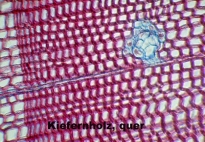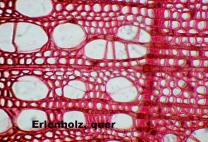 |
 |
| Pine | Alder |
ANATOMY
OF PLANTS
Making
sections of botanic material is not very difficult. Even amateurs can do it
successfully and processing those sections afterwards is no serious problem.
Such sections are not only very interesting, they are very instructive as well.
Compare the cross section of pine wood with the cross section of alder wood! Conifers possess only one type of wood-forming cells, whereas hardwood has at least two types of them: Large water transporting vessels and much smaller wood fibres which give the wood its stability. In addition conifers have resin ducts (blue stained in the left picture) which are missing in hardwoods.
With the help of appropriate tables
you can identify the genus, often even the species of trees whose wood is microscopically
examined. If you find out that a medieval statue of a saint has been made of
Canadian spruce, cover it with some more dust and mildew and sell it as soon
as possible to someone who has no microscope!
But sections reveal even more: We
can in fact reconstruct the habitat of an unknown plant. The cross section of
the leaf of an oleander shrub displays at the top a thick cuticle, impermeable
for water and air, then a multi-layered epidermis of dead cells, filled with
air (thermal insulation) and a massive, multi-layered palisade parenchyma, in
which the assimilation takes place. Because assimilation stops at high light
intensities a thick palisade parenchyma provides a great advantage: At low light
intensity assimilation takes place in the top layer, at high light intensity
the top layer becomes a solar filter and the assimilation takes place in the
deeper layers. So a plant with such leaves is adapted to a very sunny and dry
location at the same time. This is supported by the tiny stomata at the bottom
of the leave, which open into small cavities, and these cavities are filled
with hairs as an additional protection against evaporation.
All the details shown in the pictures
above you can also see in fossilized remains of plants, so it is possible to
reconstruct the environment of dinosaurs by analysing the non-spectacular remains
of plants found together with the skeletons.
As a final example, consider a longitudinal section through the vascular bundles of a pumpkin plant: The massive water transporting vascular bundles with their wall stiffenings clearly illustrate that this plant has a large demand for water - if you look at the water content of a ripe pumpkin this is no wonder.
Copyright: webmaster@mikrohamburg.de